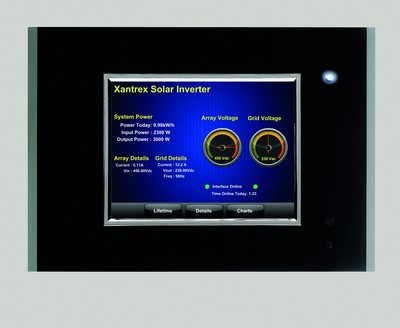Amplified lifestyle, reduced energy
Friday, 08 February, 2013
In times of rising energy costs, government incentives and a desire to reduce household bills, solar installations are becoming increasingly common in residential applications. Coupled with a desire for the comfort and lifestyle benefits afforded by a control and management system, today’s homeowner demands a sophisticated integration of the two. The question for today’s contractor is how to effectively deliver all the advantages and maximise client investment.
The Clipsal C-Bus control and management system is used to automatically control lighting, security, audiovisual equipment and other services in the home. Interface methods are plentiful; touch screens, wall switches and sensors for direct control, as well as remote options. It is easy to expand functionality and enhance convenience through integration with third-party systems.

Clipsal’s range of Xantrex GT solar inverters is recognised for high efficiency, low installation costs, improved aesthetics and high reliability. The most critical part of a solar installation, the inverter is used to convert energy captured by solar panels into electricity to be used in the home or exported back to the grid. The more efficient the inverter, the more efficient the entire installation is.
To make the best of use of two seemingly disparate systems, they need to be interconnected. In this scenario, a serial cable is run between a C-Bus colour touch screen and a Xantrex inverter. Serial communications present distance limitations of around 15 m, so this can also be carried out utilising an ethernet to serial solution. Commands sent from the touch screen request data from the inverter, which then displays on the touch screen.

In non-integrated projects, the home control system and solar system work independently of each other, meaning that the benefits of energy harvesting are not realised. Seamlessly incorporating the two gives the homeowner additional convenience and potential energy and cost savings. Monitoring energy output for display on the touch screen is simple and allows the user to determine which electrical services can be turned on or off, depending on current energy production levels. For instance, a homeowner could elect to turn on non-essential items, such as pool pumps, during periods of excess solar production, rather than feeding it back on to the grid. Likewise, in times of low solar energy production, the system can be programmed to shut down nominated electrical services, saving energy and money by not drawing power from the grid.
In addition to real-time monitoring, the homeowner can view historical data to ascertain energy production levels over a given period.
Tackling EV misinformation at Everything Electric
Lauren Davis discusses all things EV with Robert Llewellyn, Red Dwarf cast member...
Let's talk about electrification, digitalisation and decarbonisation
Can the building sector use AI tools as a binding force for different energy efficiency processes?
A connected world: how smart systems are enhancing sustainability
The drive for smarter, smoother, more efficient connected and integrated infrastructure is often...




